Tekton Design 4-10 Subwoofer by Richard Willie
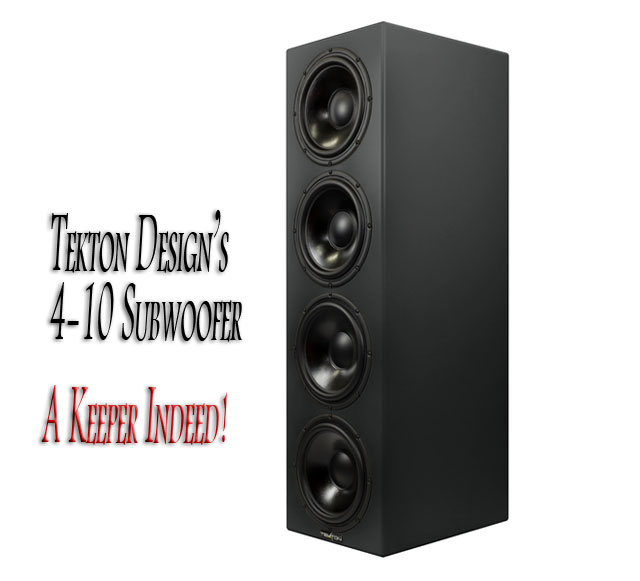
Tekton Design 4-10 Subwoofer
 I have a love-hate relationship with subwoofers; or at least I did. The Tekton Design 4-10 Subwoofers have proven to be some of the easiest subs I’ve ever set up, with the uncanny ability to melt into the rest of the system and disappear so completely that I sometimes forget they are there. If anything, my time with the 4-10’s have persuaded me to think of subwoofers less as bulky and sometimes superfluous appendages, and more of an integral part of a well-balanced stereo system. I have thoroughly enjoyed having the Tekton 4-10 subwoofers in my home for review, and like the Tekton Double Impacts, they represent one of the greatest price/performance ratios in the subwoofer market.
I have a love-hate relationship with subwoofers; or at least I did. The Tekton Design 4-10 Subwoofers have proven to be some of the easiest subs I’ve ever set up, with the uncanny ability to melt into the rest of the system and disappear so completely that I sometimes forget they are there. If anything, my time with the 4-10’s have persuaded me to think of subwoofers less as bulky and sometimes superfluous appendages, and more of an integral part of a well-balanced stereo system. I have thoroughly enjoyed having the Tekton 4-10 subwoofers in my home for review, and like the Tekton Double Impacts, they represent one of the greatest price/performance ratios in the subwoofer market.
Description
The Tekton 4-10 subwoofer looks more like a loudspeaker than anything else. In my listening space, the pair of 4-10 subwoofers are positioned immediately adjacent to my Tekton Double Impact loudspeakers. The Double Impacts are physically larger than most loudspeakers, and the Tekton 4-10 subwoofers are not far behind. The two are nearly identical in width and depth, with the 4-10 subwoofer being approximately 9-inches shorter than the Double Impacts. Those who have visited my home are more apt to ask “what are those,” rather than immediately recognize them as subwoofers.
I live relatively close to Tekton Design, and rather than have the speakers shipped to my home, I opted to pick them up in person, tour the facility, and discuss all things audio with Tekton’s Founder, Eric Alexander. One of the lesser known facts about Eric is that he loves restoring cars. Interestingly, Eric sees striking similarities between car engines, and subwoofer pistons; he explains that like engines, a subwoofer designer can reduce the stroke distance of a subwoofer piston by increasing the number of woofers. The displacement of air is the same, even though each subwoofer piston is moving only a fraction of the distance.
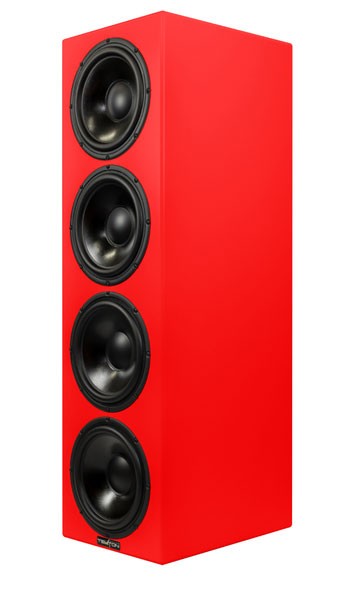
One of the most striking visual characteristics of the 4-10’s (and the subwoofer’s namesake), are the stacked line of 10-inch woofers. Although not exactly novel in concept, it is this somewhat unique array of woofers that is partially responsible for the 4-10’s character. Instead of radiating from a relatively localized source and expanding in a way that’s conceptually similar to a balloon being blown up, soundwaves from the 4-10 subwoofer are more analogous to an expanding column of air. The result is tighter bass, and a more even distribution of sound than is achievable with one woofer alone.
For those with smaller listening spaces, the Tekton 4-10 represents a very large subwoofer, with a reasonably sized footprint. The combined displacement of the four 10-inch woofers is greater than that of a single 16-inch woofer, yet the footprint of the subwoofer is closer to that of a traditional loudspeaker. The 4-10’s are the “skyscrapers” of the subwoofer world, making them a bit more friendly for those in confined spaces.
Subwoofers for a dedicated two-channel system benefit from having a slightly different feature set than a ‘home theater’ subwoofer. Fortunately, the Tekton 4-10’s include all the features I consider critical to a two-channel subwoofer. For instance, the Tekton 4-10 subwoofers are a sealed design, which eliminates much of the ringing and overhang introduced by a ported system, resulting in a faster, tighter, and more musical sound. Around back of the 4-10 subwoofer, the plate amplifier sports a set of line level inputs as well as high-level inputs, in addition to gain, phase, and low pass filter adjustments. Simply stated, the Tekton 4-10 subwoofer covers all the bases, without unnecessary frills or bloat.
Setup
 Subwoofers can be tricky beasts; as it turns out, there are more ways to setup a subwoofer incorrectly, than correctly. Between the extraordinarily long frequency wavelengths with concomitant room nodes, equipment incompatibilities, and technical competence required to set them up, I suspect many audiophiles simply “write-off” subwoofers as being the province of budget home theater systems. Undoubtedly, successfully setting up a subwoofer (or two) requires time, patience, tenacity, and sometimes a bit of luck. Find yourself missing some of these key ingredients, and you might also find yourself on a path of frustration and less than adequate bass. Fortunately, the web is abound with tutorials that can get you on the right track to setting up a subwoofer. This is not one of those tutorials; though I will touch on a couple of pitfalls and tips I’ve learned along the way.
Subwoofers can be tricky beasts; as it turns out, there are more ways to setup a subwoofer incorrectly, than correctly. Between the extraordinarily long frequency wavelengths with concomitant room nodes, equipment incompatibilities, and technical competence required to set them up, I suspect many audiophiles simply “write-off” subwoofers as being the province of budget home theater systems. Undoubtedly, successfully setting up a subwoofer (or two) requires time, patience, tenacity, and sometimes a bit of luck. Find yourself missing some of these key ingredients, and you might also find yourself on a path of frustration and less than adequate bass. Fortunately, the web is abound with tutorials that can get you on the right track to setting up a subwoofer. This is not one of those tutorials; though I will touch on a couple of pitfalls and tips I’ve learned along the way.
Stereo System – Stereo Subs
I’m convinced that setting up a stereo system with just one subwoofer is a fool’s errand. The magic of a stereo system is attributable (in part) to the creation of the illusion of three dimensional music through a pair of nearly identical sources. Despite the fact that subwoofers roll off high-frequencies, this typically occurs at a 12 dB per octave slope. Even if they are not immediately noticeable, higher frequencies are always reproduced to a certain extent. A single subwoofer has the potential to inadvertently detract from the illusion by creating a secondary musical image that is slightly offset from the loudspeaker image. The subwoofer will tend to call attention to itself, and it will be difficult to get it to disappear into the background. Suffice to say, this is a review of a stereo pair of 4-10 subwoofers, for just that reason.
Subwoofer Position
Buckets of ink have been spilled on optimal subwoofer positioning, and an in-depth discussion is simply beyond the scope of this review. However, it is notable that Eric Alexander recommended placing one subwoofer flanking each of the Tekton Double Impacts for optimal results (and quite possibly the best aesthetic result). Once set in their flanking position, I didn’t move the 4-10’s again.
Low Level vs. High Level Inputs
For a dedicated two channel setup, high-level inputs on a subwoofer can be worth their weight in gold. Subwoofers with only low-level inputs create some interesting problems for stereo preamplifiers without a .1 output. If a subwoofer doesn’t have high-level inputs, the next alternative is to simply let the preamp drive the combined impedance of the amplifier and the subwoofer together. This can be especially problematic for tube preamplifiers, which often have rising output impedances at lower frequencies.
 This problem hit me right between the eyes when I was using an older B.A.T. VK51se to drive an SVS SB16. My Pass Labs XA30.8 is relatively easy to drive, with a balanced input impedance of 100K Ohm. The SVS SB-16 on the other hand is not as easy to drive; its balanced input impedance was 22K Ohm. Together, the B.A.T. preamp saw a combined impedance of 18K Ohm. While this may not bother some solid state amplifiers, the VK51se had an output impedance of nearly 5K Ohms in the bass frequencies! Not exactly the model 10-to-1 impedance ratio we strive for in hi-fi audio. The result? Languid, soft, and uninspiring bass. In that system, the SB-16, which only had low level inputs, actually made the bass sound worse than no subwoofer at all. Rather than a pejorative anecdote of either SVS’s or B.A.T.’s products (both of which are highly regarded in their own right), this is intended to show the consequences of poor compatibility between components that can be alleviated through the inclusion and use of high-level inputs.
This problem hit me right between the eyes when I was using an older B.A.T. VK51se to drive an SVS SB16. My Pass Labs XA30.8 is relatively easy to drive, with a balanced input impedance of 100K Ohm. The SVS SB-16 on the other hand is not as easy to drive; its balanced input impedance was 22K Ohm. Together, the B.A.T. preamp saw a combined impedance of 18K Ohm. While this may not bother some solid state amplifiers, the VK51se had an output impedance of nearly 5K Ohms in the bass frequencies! Not exactly the model 10-to-1 impedance ratio we strive for in hi-fi audio. The result? Languid, soft, and uninspiring bass. In that system, the SB-16, which only had low level inputs, actually made the bass sound worse than no subwoofer at all. Rather than a pejorative anecdote of either SVS’s or B.A.T.’s products (both of which are highly regarded in their own right), this is intended to show the consequences of poor compatibility between components that can be alleviated through the inclusion and use of high-level inputs.
The point remains, this is a somewhat common issue between subwoofers and stereo tube preamplifiers. Fortunately, the Tekton 4-10 subwoofer includes high-level inputs, which largely obviates the issue, though knowledge of this did not stop me from experimenting with the low-level inputs as well.
While using the PS Audio BHK to drive the Tekton 4-10 subwoofers through the low-level inputs, the problem discussed above was less pronounced, but still noticeable. The PS Audio BHK preamp has a solid state output stage, and the output impedance doesn’t slope upwards in the bass region in the same way that the VK51se does. But the principles of combined impedance were still in play, and the bass was rolled off, less punchy, and less lively than when the high-level inputs were used. In short, I recommend the use of high-level inputs for stereo subs; leave the line-level inputs to AV receivers or preamplifiers with a dedicated .1 output.
Port Plugs and Low Pass Settings
Integrating a subwoofer into a stereo setup is an iterative (read tedious) process. In my case, the low pass setting was tied to another decision point in my setup – whether to use port plugs with the Double Impacts, or not.
There are compelling arguments to be made for using port plugs on a pair of full range loudspeakers when integrating a subwoofer. The reasoning goes that port plugs will alter the frequency and phase response in the lower bass range of the loudspeakers, resulting in a smoother low frequency roll off that better matches the subwoofer 12 dB per octave roll off. Moreover, in cases where the subwoofer is a sealed design (like the Tekton 4-10’s), using port plugs on loudspeakers will reduce their overhang and ringing due to energy stored in the porting system, and will produce a closer match in response and speed to the subwoofer.
 Plugging the ports of the Tekton Double Impacts had some interesting effects. For starters, the Double Impacts had tighter bass, but required more compensation from the subwoofer. In this configuration, the bass seemed to be tighter and exuded greater resolution, but also sounded drier, less natural, and had a grainier feel; moreover, these sound qualities seemed to saturate well into the midrange, not just the bass. Plugging the bass ports altered the fundamental character of the Double Impacts, and after several extended listening sessions, I decided this wasn’t my cup of tea.
Plugging the ports of the Tekton Double Impacts had some interesting effects. For starters, the Double Impacts had tighter bass, but required more compensation from the subwoofer. In this configuration, the bass seemed to be tighter and exuded greater resolution, but also sounded drier, less natural, and had a grainier feel; moreover, these sound qualities seemed to saturate well into the midrange, not just the bass. Plugging the bass ports altered the fundamental character of the Double Impacts, and after several extended listening sessions, I decided this wasn’t my cup of tea.
Plugging just one speaker port yielded interesting results as well. In my room, the Double Impacts have a bit of a frequency bump in the 35-40 Hz region. I found that by plugging just one port on the Double Impacts that I could remove that bump in the frequency response, and with the 4-10 subwoofers, that I could achieve a basically flat frequency response all the way to 20 Hz. This is somewhat remarkable, because in the past, I have only realized flat frequency responses in the bass region with the help of a parametric equalizer with its accompanying detriments. Plugging one port on the Double Impacts seem to capture some of the best of both worlds; the natural lush bass of leaving the ports open, increased resolution and speed of having the ports closed, a reasonably flat frequency response down to 20 Hz, and a greater sense of space, impact, and size in the music.
Finally, leaving the ports open retained the Double Impact’s house sound while keeping the subwoofers in a purely reinforcing role (as opposed to outright bass replacement). I found this configuration sounded best with the low-pass filter turned all the way down to 40 Hz. The smooth, dark, natural, and lush sound of the Pass Labs XA30.8/Double Impact combo returned, but this time supplemented by the 4-10 subwoofers there was improved low end impact, and a greater sense of space and size. The sound in this configuration just had a “rightness” to it that I found slightly more satisfying than having one port plugged. In all reality, I think an end-user could live happily with either configuration
Phase
 My unimaginative choice in positioning was made in part due to my desire to match the phase angle between the loudspeaker woofers, and the subwoofers. Speaker phase is one of those things that is easy to get wrong, and one of the more important parts of ensuring that the subwoofers “disappear” into the loudspeaker sound. When subwoofers are mildly out of phase, they don’t sound right and the soundstage suffers; when they are significantly out of phase, the subwoofer and loudspeaker may actually work against each other.
My unimaginative choice in positioning was made in part due to my desire to match the phase angle between the loudspeaker woofers, and the subwoofers. Speaker phase is one of those things that is easy to get wrong, and one of the more important parts of ensuring that the subwoofers “disappear” into the loudspeaker sound. When subwoofers are mildly out of phase, they don’t sound right and the soundstage suffers; when they are significantly out of phase, the subwoofer and loudspeaker may actually work against each other.
Choosing the optimal phase angle is both simple, and complex. It’s simple from the standpoint that you can get a rough estimate of the optimal phase angle by simply listening to when the bass is the loudest while adjusting the phase angle knob. Its complex because for any given frequency, the correct phase setting on the subwoofer could be different; that is, a good phase setting at 40Hz may be different than a good setting at 60Hz (plugging the ports also changes the correct phase setting).
That notwithstanding, I found setting the phase angle on the 4-10 subwoofers a quick and easy process using a MiniDSP UMIK-1 microphone and iPhone. When setting the phase angle, I simply attached the UMIK-1 with its 2 meter long USB cable to my iPhone. From there, I was able to place the microphone in front of the subwoofer and loudspeaker and measure the amplitude of test tones on the iPhone Real Time Analyzer (RTA) app. Once in place, I adjusted the phase setting until I reached the maximum amplitude for a given frequency, and thus, “in-phase” for that given point. When I dialed in the phase angle with a 50 Hz test tone, the slight haze that the subwoofers had been producing disappeared, the bass images snapped into focus, and the soundstage exploded in depth. Like magic.
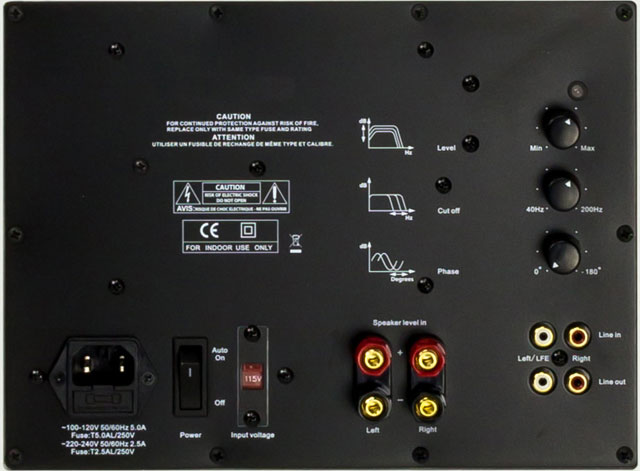
Gain Settings
 With a virtually unlimited reservoir of bass on tap, it’s easy to take the lyrics, “it’s all about the bass…” to its extreme. But, one of the first rules of setting up subwoofers, is that they should not draw attention to themselves. Properly adjusted, subwoofers provide increased soundstage, and a foundation for the rest of the music. Too much bass, and the subwoofers become a smothering blanket that distracts from the rest of the music.
With a virtually unlimited reservoir of bass on tap, it’s easy to take the lyrics, “it’s all about the bass…” to its extreme. But, one of the first rules of setting up subwoofers, is that they should not draw attention to themselves. Properly adjusted, subwoofers provide increased soundstage, and a foundation for the rest of the music. Too much bass, and the subwoofers become a smothering blanket that distracts from the rest of the music.
Setting the gain of the subwoofers is better done by ear, than by measurement. The amount of gain needed will largely depend upon the typical listening level. Fletcher-Munson curves dictate, but the cliff notes version is that the lower the volume level, the more bass that is needed to “sound right.” Additionally, whenever possible, the bass levels between the left and right subwoofers should be about the same to maintain stereo imaging.
The Sound
The Pass Labs XA30.8 is an absolutely stunning amplifier, especially when paired with the Tekton Double Impacts. While the XA30.8 embodies some of the best qualities of Class A amplification, it isn’t exactly known for bone-crushing bass performance. For me, the Pass Labs/Tekton system produces a sound that checks almost all of the boxes. Yet, I’ve always had a nagging sensation that the bass could use something just a bit more. That’s exactly what the Tekton 4-10 subwoofers provide.
The Tekton Design 4-10 subwoofers exemplify a couple of sound characteristics that I attribute, at least in part, to the 4-10’s use of an array of woofer cones. First, each of the four drivers need only travel a short distance when compared to a single driver with a larger excursion, making the bass from the 4-10 subwoofers faster and tighter than many other subwoofers I have heard. Second, and somewhat unique to the multiple driver design, the bass seems to be more evenly distributed throughout the room.
Something that has bothered me in the past with single-driver subwoofer designs is the fact that their sound can often be separate and distinct from that of the loudspeaker. Even though the subwoofer produces prodigious bass, that sound is unmistakably coming from a box that is situated on the floor, not the loudspeakers. The 4-10’s don’t sound like that. The bass the 4-10’s produce is at a height that extends from the floor to nearly the height of most loudspeakers. This produces a sensation of bass that is not only evenly distributed through the room, but much more coherent and integrated with the rest of the frequency range. These characteristics can be clearly heard in a couple of different tracks.
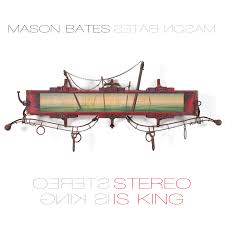 Mason Bates 2014 release by Innova, “Stereo is King,” is an album that demands deep effortless bass. Many of Mason Bates’ works incorporate a unique combination of electronic instruments to augment more orchestral compositions. Case in point is the title track, “Stereo is King,” which is a percussive piece throughout, showcasing Thai and Tibetan instruments floating over an electronic foundation of bass. Listening without subwoofers is fine, I guess… I understand what Mason Bates was trying to communicate, but without subwoofers, I’m ultimately left with the feeling that I’ve missed the point; the Tekton 4-10 subwoofers truly make or break this piece. With the Tekton 4-10 subwoofers, the track is alive, interesting, and impactful from the start with a tremendous sense of space and beautiful examples of uncompressed electronic bass.
Mason Bates 2014 release by Innova, “Stereo is King,” is an album that demands deep effortless bass. Many of Mason Bates’ works incorporate a unique combination of electronic instruments to augment more orchestral compositions. Case in point is the title track, “Stereo is King,” which is a percussive piece throughout, showcasing Thai and Tibetan instruments floating over an electronic foundation of bass. Listening without subwoofers is fine, I guess… I understand what Mason Bates was trying to communicate, but without subwoofers, I’m ultimately left with the feeling that I’ve missed the point; the Tekton 4-10 subwoofers truly make or break this piece. With the Tekton 4-10 subwoofers, the track is alive, interesting, and impactful from the start with a tremendous sense of space and beautiful examples of uncompressed electronic bass.
 In 1994, the Eagles released their “Hell Freezes Over” (by Geffen) album after a fourteen year hiatus. While the album didn’t garner the critical acclaim of their prior works, it still has my favorite version of “Hotel California.” The track was recorded live with a flamenco style acoustic guitar introduction, which is decidedly divergent from the album version, and a close-miked kick-drum follows, keeping pace through the entire track. While this track sounds quite good through the XA30.8 and Tekton Double Impacts alone, the 4-10 subwoofers add new dimension to the track. The 4-10’s make the entire presentation larger with greater spatial depth, there is a certain effortlessness to the bass, and the low end has more punch and snap to it.
In 1994, the Eagles released their “Hell Freezes Over” (by Geffen) album after a fourteen year hiatus. While the album didn’t garner the critical acclaim of their prior works, it still has my favorite version of “Hotel California.” The track was recorded live with a flamenco style acoustic guitar introduction, which is decidedly divergent from the album version, and a close-miked kick-drum follows, keeping pace through the entire track. While this track sounds quite good through the XA30.8 and Tekton Double Impacts alone, the 4-10 subwoofers add new dimension to the track. The 4-10’s make the entire presentation larger with greater spatial depth, there is a certain effortlessness to the bass, and the low end has more punch and snap to it.
 It’s always interesting to me how the musical progressions of jazz musicians can be so unique, almost like a fingerprint. I remember walking down an office hallway and hearing the distinctive improvisation of Robert Glasper; I had never heard that particular piece before, but immediately recognized it as being Glasper’s work. Glasper’s “Covered” album released by Blue Note records, is an album which Glasper describes as covers of music he likes to listen to on his iPod, and which contains several instances of these unique improvisations. One of my favorite tracks from the record, “The Worst (Jhene Aiko)” starts with a piano melody and is later filled in with stand-up bass and drums. This track stands out as being wonderfully warm and inviting, with a healthy amount of natural bass. Without the Tekton 4-10 subwoofers, the track sounds great, but with the nagging feeling that something is missing. When added to the system, the 4-10 subwoofers add the last bit of weight that really anchor the track to complete the sound. The bass line is filled out, the drums come to life, all while creating a greater sense of space in the room. In short, that nagging feeling that something is missing is gone.
It’s always interesting to me how the musical progressions of jazz musicians can be so unique, almost like a fingerprint. I remember walking down an office hallway and hearing the distinctive improvisation of Robert Glasper; I had never heard that particular piece before, but immediately recognized it as being Glasper’s work. Glasper’s “Covered” album released by Blue Note records, is an album which Glasper describes as covers of music he likes to listen to on his iPod, and which contains several instances of these unique improvisations. One of my favorite tracks from the record, “The Worst (Jhene Aiko)” starts with a piano melody and is later filled in with stand-up bass and drums. This track stands out as being wonderfully warm and inviting, with a healthy amount of natural bass. Without the Tekton 4-10 subwoofers, the track sounds great, but with the nagging feeling that something is missing. When added to the system, the 4-10 subwoofers add the last bit of weight that really anchor the track to complete the sound. The bass line is filled out, the drums come to life, all while creating a greater sense of space in the room. In short, that nagging feeling that something is missing is gone.
Conclusion
The value of the Tekton Design 4-10 subwoofer exceeds virtually every subwoofer around its price point, and are exemplars of every trait I feel are critical to subwoofers in a dedicated stereo system. More than any other subwoofer I’ve heard, the 4-10 subwoofers melt into the rest of the system; quite simply, they disappear with a sound that is indistinguishable from the loudspeaker. Beyond that, the Tekton 4-10 subwoofers add a sense of dynamic contrast, a greater sense of space, effortless lows with added kick, a fuller and richer sound, and (oddly) the added low end seems to make the highs sparkle a bit more. Such an improvement is hard to believe from speakers that cover such a narrow slice of the frequency range.
Subwoofers typically don’t survive in my system for very long. Once the novelty of shaking pictures off the walls wears off, I’m often left with a feeling that I might be better off with no subwoofer at all. Without exception, once I’ve removed subwoofers from my system, I’ve preferred the pure sound of un-reinforced two channel music. I find it somewhat remarkable that these subwoofers have survived an extended period of critical evaluation and haven’t been shown the door. Needless to say, they’re keepers.

Richard Willie

Specifications:
Price: $800 ea
Website: www.Tektondesign.com
Stereo Times Masthead
Publisher/Founder
Clement Perry
Editor
Dave Thomas
Senior Editors
Frank Alles, Mike Girardi, Russell Lichter, Terry London, Moreno Mitchell, Paul Szabady, Bill Wells, Mike Wright, and Stephen Yan,
Current Contributors
David Abramson, Tim Barrall, Dave Allison, Ron Cook, Lewis Dardick, John Hoffman, Dan Secula, Don Shaulis, Greg Simmons, Eric Teh, Greg Voth, Richard Willie, Ed Van Winkle, Rob Dockery, Richard Doran, and Daveed Turek
Site Management Clement Perry
Ad Designer: Martin Perry



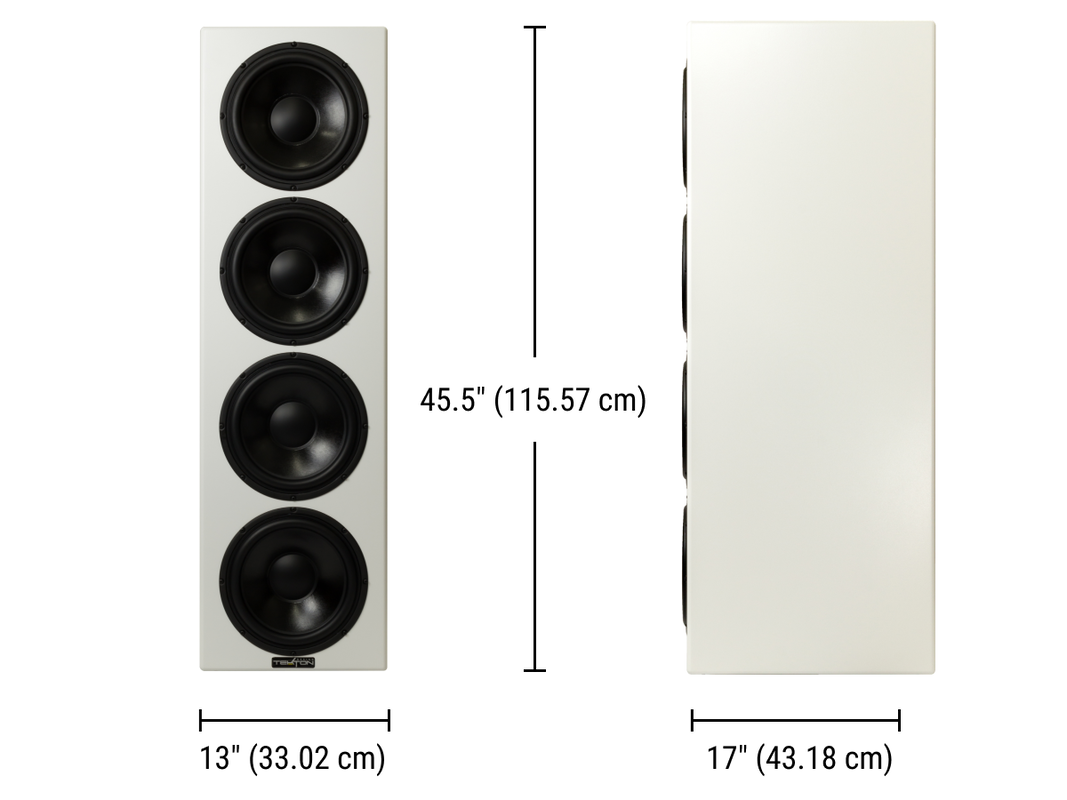




Be the first to comment on: Tekton Design 4-10 Subwoofer by Richard Willie